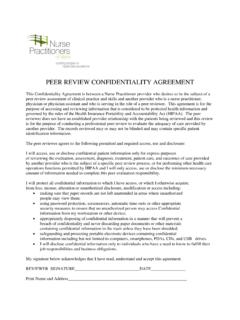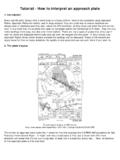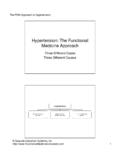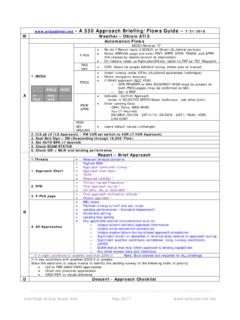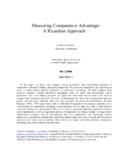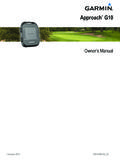Transcription of Topical Pain Medications: Another Approach to …
1 Topical pain Medications: Another Approach to pain , Wound and Scar Management Elaine Ladd, PharmD, BCPS. Ladd Family Pharmacy August 24, 2013. This Talk Will Cover . Brief overview of the categories of pain Review opioid pharmacology Review the available treatment modalities and alternative options for pain management Discuss alternative options for wound treatment Discuss alternative options for scaring Pharmacy Compounding Art and science of preparing customized medications Today an estimated 10% of all prescriptions and medication orders are compounded NECC fallout and impact Proposed legislation Fear, Understanding, Doubt (FUD). Ask questions like these listed below. X. Is your staff properly trained and evaluated in non-aseptic manipulation skills, gowning technique and compounding room use?
2 Do you have systems in place for handling complaints and investigating adverse events? Do you purchase pharmaceutical-grade chemicals (USP, NF equivalent) from FDA- registered suppliers? Do you obtain Certificate of Analyses for all formula ingredients? Do you maintain both master formulas and lot-specific worksheets for all compounds? Can you immediately trace a prescription back to the original formula log sheet and the source of ingredients? Is every step of the compounding process from prescribing to compounding and labeling through dispensing reviewed and verified by a licensed pharmacist? Do you verify the potency of finished compounds via weight, volume and yield checks and can share the results within 48 hours? Are your pharmacists, technical and customer care staff dedicated to compounding?
3 pain . pain Introduction pain is an unpleasant sensory and emotional experience Every individual is unique and the pain experience can be equally diverse billion people worldwide suffer from chronic pain of the global population suffers from neuropathic pain , incidence rate increases with age1. Back pain is the leading cause of disability in Americans under 45 years old2. More than 26 million Americans between the ages of 20-64 experience frequent back pain2. 1) Global Industry Analysts, Inc. Report, January 10, 2011. 2) National Centers for Health Statistics, Chartbook on Trends in the Health of Americans 2006, Special Feature: pain . Incidence of pain . American Academy of pain Medicine Condition Number of Sufferers Source Chronic pain 100 million Americans Institute of Medicine of The National Academies3.
4 Diabetes million Americans American Diabetes (diagnosed and estimated Association4. undiagnosed). CHD million Americans American Heart Association5. (heart attack and chest pain ). Stroke million Americans Cancer million Americans American Cancer Society6. 3) Institute of Medicine Report from the Committee on Advancing pain Research, Care, and Education: Relieving pain in America, A Blueprint for Transforming Prevention, Care, Education and Research. The National Academies Press, 2011. 4) American Diabetes Association. 5) Heart Disease and Stroke Statistics 2011 Update: A Report From the American Heart Association. Circulation 2011, 123:e18-e209, page 20. 6) American Cancer Society, Prevalence of Cancer: 5 Major Categories of pain Inflammatory response to tissue damage that potentiates pain Proinflamatory mediators peripheral sensitization Phenotypic switch (chemical and physical change in character and function of nerves neuroplastic change).
5 Central sensitization Soft tissue pressure ulcers, burns Intracranial pressure brain tumor edema and hemorrhage 5 Major Categories of pain Nociceptive CNS and peripheral afferent pathways modulated via spinal cord Somatic aching, constant, localized (musculoskeletal). Visceral sharp, crescendo/decrescendo (cholecystitis, renal stones, intestinal obstruction, MI). Neuropathic ischemia, destruction or encroachment of nerve by disease or tumor Paroxysmal shooting or shock-like pain on a background of burning, aching sensation Opioid Pharmacology Opioid: Narcotic or opiate-like drugs, include natural, synthetic, and endogenous ligands/substances Receptor site: that portion of a nerve cell to which a drug can bind. There are several opioid receptor sites, , mu (beta-endorphins), kappa (dynorphins) and delta (met- & leu-enkephalins).
6 Opioid Pharmacology Agonist: in large enough doses, this type of drug binds to a specific site and initiates activity at that receptor site. Types of agonist: Pure agonist binds tightly with the receptor site and produces the near maximal activity possible at that receptor site. Partial agonist binds with the receptor site less tightly than a pure agonist Opioid Pharmacology Antagonist: in large enough doses, this type of drug binds to a specific site, or it displaces the agonist at the receptor site, thereby stopping the receptor's activity. Types of antagonist: Pure antagonist binds tightly with the receptor site and stops or blocks activity at that receptor site. Partial antagonist binds with the receptor site less tightly than a pure antagonist, stopping or blocking less of the activity at that receptor site Opioid Pharmacology Receptor Effect Location Mu Analgesia (robust) Mid-Brain/Spinal Cord Resp.
7 Depression Medulla Inhibits GI motility Intestines Euphoria Limbic system Peripheral sensory neurons Kappa Analgesia (mild) Spinal cord Inhibits GI motility Intestines Diuresis Pituitary Gland Peripheral sensory neurons Delta Analgesia (minor) Spinal Cord Tolerance Striatum/Cortex Seizures Peripheral sensory neurons Receptor Affinity of Opioid Analgesics Receptor Mu Kappa Delta NMDA. Morphine A - - - Fentanyl A - - - Hydromorphone A - - - Oxycodone A A (?) - - Methadone A - A B. Pentazocine - A - - Stadol - A - - Ketamine A (?) - A (?) B. Dextromethorphan A (?) - A (?) B. A = strong agonist - = negligible B = strong antagonist ? = questionable Modified by A. Peralta from Twycross R et al. Palliative Care Formulary. 1998. N-Methyl D-Aspartate Antagonist/Inhibitors NMDA Antagonists.
8 Blocks the amino acid glutamate from binding to NMDA. receptors reducing the depolarization of spinal cord neurons continued firing of these neurons causes hyperalgesia This increased response or hypersensitivity to a painful stimulus causes a windup phenomenon, a progressive increase in depolarization spikes that cause a single summation spike and the spontaneous firing of neurons that can persist for minutes Transdermal Treatment Transdermal delivery allows drugs to solubilize in order to penetrate the tissue layers Gels form liposomes that carry the drug down between the cells of the dermis and epidermis. Minimizes SE's by delivering drug to the site of injury. Research confirms peripheral site of action for many of these drugs. Liposomes Common Topical pain Agents Amantadine (5-20%) Ibuprofen (10-40%).
9 Amitriptyline (2-10%) Indomethocin (10-40%). Baclofen 2% Ketamine (5-10%). Bupivicaine (2-5%) Ketoprofen (10-50%). Carbamazepine 5% Lidocaine (2-10%). Clonidine ( ) Loperamide 1%. Cyclobenzaprine (1-3%) Nifedipine (2-16%). Dextromethorphan (5-10%) Orphenadrine (5-10%). Diclofenac (1-10%) Phenytoin (2-10%). Gabapentin (5-10%) Piroxicam ( ). Guaifenesin (10-40%) Tetracaine ( ). Haloperidol ( ) Topiramate 1%. Mode of Action Drug Comments Amantadine NMDA receptor antagonist, advantageous because it is not a controlled substance. Amitriptyline Has been shown to reduce nerve pain when used topically but mechanism of action is unknown. Baclofen Very effective muscle relaxant and anti-spastic agent. Thought to work by decreasing excitatory neurotransmitter release.
10 Bupivicaine Local anesthetic with double the duration of action of Lidocaine. Sodium channel blocker that works to prevent ectopic neuropathic impulses. Carbamazepine Effective for treating trigeminal neuralgia. Decreases polysynaptic responses and blocks post-tetanic potentiation. Great for relieving nerve pain . Mode of Action Drug Comments Clonidine An alpha receptor agonist useful in reducing neuropathic pain , especially syndromes with a sympathetic component. Cyclobenzaprine Muscle relaxant and anti-spastic agent that affects muscle function. Possesses anti- neuropathic properties as it is structurally related to the trycyclic antidepressants by inhibiting sodium channels. 2-Deoxy-D-Glucose A natural anti-viral from Alaskan Red Algae.
